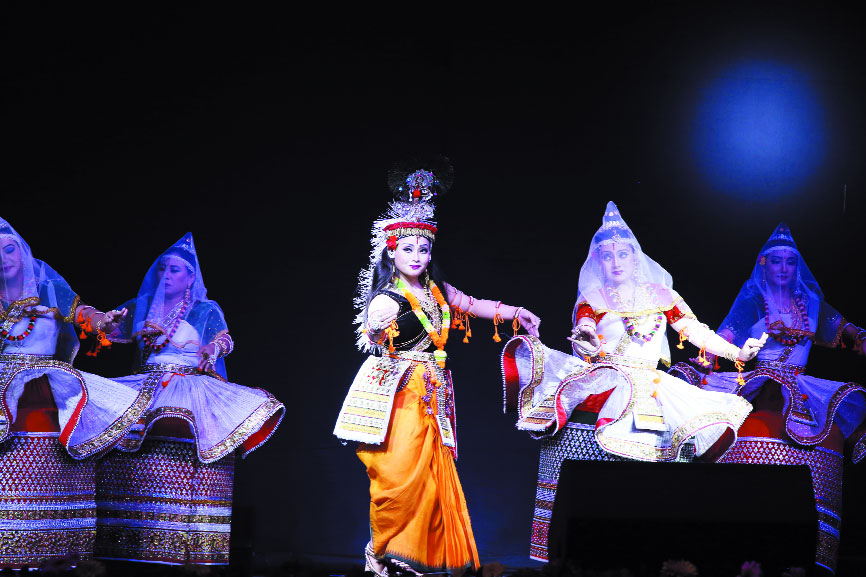The dancers performed with a swan-like grace and their floating movements evoked a celestial imagery. By Uma Nair
The Manipuri Raas Lila at the IIC Festival became the ultimate closure for a festival that celebrated the beauty and dynamic indigenous tapestry of the Northeastern states.The pristine sound of the instruments and the voice of the soloist became the invocation and the intonation for an evening of exquisite grace and divinity.
Lord Krishna dwells in those who believe in his presence. He embodies the supreme reality — the Brahma Tatwa, which is dense concentrated bliss, which is of the nature of the pure consciousness, which is without parallel or comparison and is totally free of time and space limitations.
Sacred and sublime
The recital opened with the Basanta Varnam, which describes the beauty of the van in Sringara Raas. Fluid movements and delicate flourishes echoed the trance that you could be drawn into. Haunting lyrics and pealing notes added to the evocation that stepped into the night.
The Natya Shastra states that Sringara has two varieties: union and separation. As the evening wore on, you sensed the articulation of an arduous theme that was deftly translated into dance. You also realised that an indigenous dance is able to educate both the connoisseurs and the uninitiated, making it a matter of edutainment. One wishes there was a commentary of the narrative to make the understanding of esoteric easier. The romantic verses of the narrative moved from physical yearning to spiritual elevation (masculine and feminine energies inherent in nature), the crux of the bhakti philosophy of those times and therein lay the power and the passion.
Swan-like grace
From the word go, the Basanta Varnam unravelled the epoch of the sthayi bhava in which its soul depicts a bright attire; for whatever in this world is white, pure and beautiful is appreciated in terms of sthayi bhava.
The second performance was the Samode Damodar (Hari Riha), based on the first canto of Jaydeva’s Geeta Govindam. This gave way to the incantation of the Manipuri folk song — Thoibi na Loi Karakpa — a rendition that was a repository of both resonance and heartfelt lyricism.The evening belonged to the finale, the heady Basanta Raas that celebrated the yearning as well as the union of Lord Krishna with Radha.
You could watch the swan-like grace of the dancers, watch their floating movements as if on a cloud and imagine the setting — the glances where the eyelids are not fully opened, the look of sweet surrender and serenity, perhaps tears of joy, in the alchemy of the moment which in the sacred texts is called snigdha (loving). It grows out of divine love.
Music of the gods
Lessons from the Puranas came through the exquisite evening. Watching them sail through the sacred notes, you imagine that every human being is at once milkmaid and Krishna. We yearn for the music of the Gods and are also capable of creating the music. Lord Krishna is like a universal goalpost embodying infinity that inspires. Can we in this millennial world full of materialism attempt to walk in that direction?
Scholars state that in the Raas Lila, Lord Krishna makes music not for his pleasure but for the uplift of the milkmaids. The flute is both the melody and the instrument of divinity and delight in the coalescing of deep love. If the melody invites, it also encourages us to partake of the divine play in full spirit but with purity in our souls.
King Bhagya Chandra
The evening bore testimony to King Bhagya Chandra who composed three of these dances and created history. Rajarshi Bhagya Chandra, also known as Jai Singh Maharaj and Ningthou Ching-Thang Khomba, the 18th century monarch of the Meitei people who adopted Gaudiya Vaishnavism, recorded and systematised Manipuri dance, elaborating the basics of dance in the text Govinda Sangeet Lila Vilasa. He is credited with composing three forms of the Raas Lila — Kunja Raas, Basanta Raas and Maha Raas, which were staged during his reign at Imphal’s Sri Sri Govindaji temple.
Silent beauty
The leitmotif of the evening lay in the distinctive abhinay, the expression that is exhibited through the movements of the body and the feet and the face is cloaked and clothed in serenity with a diaphanous veil. All feelings emanate from the movement of the limbs, at once smooth as satin and flowing like a river. Shringar or love then consists of viyog (separation) and sambogh (union). Graceful restraint and unparalleled fluidity strung an evening worth remembering. The nodes of India’s heritage lie in its indigenous arts and it needs to be supported, nurtured and cherished for the ages. For the North Eastern Council and the IIC, this was an epic statement.
(The writer is an art critic.)
























